Meadows Center investigates fish kill on Cypress Creek
Posted by Jayme Blaschke
University News Service
September 30, 2013
|
|
Cypress Creek in Wimberley recently experienced a fish kill of 25 largemouth bass and sunfish on Sept. 9, 2013. Texas Parks and Wildlife’s Kills and Spills was contacted by Nancy Russell, a Texas Stream Team citizen scientist. Alan Butler from TPWD investigated the report on September 12, 2013 and concluded that the fish kill was caused by low dissolved oxygen levels.
The low dissolved oxygen likely resulted from effects of afternoon thunderstorms. During hot weather, surface water and deeper waters form a thermocline, or layer separating the regions of temperature. All photosynthesis and oxygen production occurs in the warmer surface waters. When thunderstorms drop cold rainwater on the surface of the creek, the thermocline is broken and the oxygen-deficient deeper water mixes with the surface water limiting the oxygen in the water column and can potentially cause fish kills. These effects can be exacerbated by low flow levels that cause the water to stagnate. This fish kill occurred when Jacobs Well, an artesian spring at the headwaters of Cypress Creek, stopped flowing for only the fifth time in recorded history.
Butler reported noticing a strong sulfur dioxide smell at the site. Sulfur dioxide is the byproduct of anaerobic bacteria that are present in sediments with little or no oxygen as was most likely the case with the creek bottom.
The Wimberley Valley Watershed Association and the Texas Stream Team at The Meadows Center for Water and the Environment will work with Kills and Spills Team biologists to continue to monitor the site to identify fish that are stressed or dying. Cypress Creek Project is a Watershed Protection Planning effort facilitated by The Meadows Center for Water and the Environment to help the community keep the creek clean, clear and flowing.
For more information, contact The Meadows Center at meadowscenter@txstate.edu.
